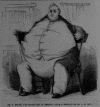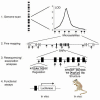Do allelic variants of SLC6A14 predispose to obesity?
- PMID: 14660737
- PMCID: PMC281657
- DOI: 10.1172/JCI20448
Do allelic variants of SLC6A14 predispose to obesity?
Abstract
Obesity is arguably the world's most prevalent nutritional disorder and is a substantial contributor to morbidity and early mortality. Obesity is known to have a strong genetic component, but the specific influential genes in humans are largely unknown. A new paper describes a genetic variant that appears as though it may cause some people to be fatter or thinner than others (see the related article beginning on page 1762). This commentary considers the strength of the evidence in support of this finding and discusses additional research questions that should be addressed in further evaluations of this genetic variant as a putative contributor to human obesity.
Figures


Comment on
-
The SLC6A14 gene shows evidence of association with obesity.J Clin Invest. 2003 Dec;112(11):1762-72. doi: 10.1172/JCI17491. J Clin Invest. 2003. PMID: 14660752 Free PMC article.
Similar articles
-
The SLC6A14 gene shows evidence of association with obesity.J Clin Invest. 2003 Dec;112(11):1762-72. doi: 10.1172/JCI17491. J Clin Invest. 2003. PMID: 14660752 Free PMC article.
-
[Genetic determinants of obesity. Current issues].Bundesgesundheitsblatt Gesundheitsforschung Gesundheitsschutz. 2010 Jul;53(7):674-80. doi: 10.1007/s00103-010-1078-z. Bundesgesundheitsblatt Gesundheitsforschung Gesundheitsschutz. 2010. PMID: 20631977 Review. German.
-
Genetic predisposition to obesity and lifestyle factors--the combined analyses of twenty-six known BMI- and fourteen known waist:hip ratio (WHR)-associated variants in the Finnish Diabetes Prevention Study.Br J Nutr. 2013 Nov;110(10):1856-65. doi: 10.1017/S0007114513001116. Epub 2013 May 14. Br J Nutr. 2013. PMID: 23668671 Clinical Trial.
-
Extreme obesity is associated with variation in genes related to the circadian rhythm of food intake and hypothalamic signaling.Physiol Genomics. 2015 Jun;47(6):225-31. doi: 10.1152/physiolgenomics.00006.2015. Epub 2015 Mar 24. Physiol Genomics. 2015. PMID: 25805767
-
[Posttraumatic stress disorder (PTSD) as a consequence of the interaction between an individual genetic susceptibility, a traumatogenic event and a social context].Encephale. 2012 Oct;38(5):373-80. doi: 10.1016/j.encep.2011.12.003. Epub 2012 Jan 24. Encephale. 2012. PMID: 23062450 Review. French.
Cited by
-
Amino Acid Transporter SLC6A14 (ATB0,+) - A Target in Combined Anti-cancer Therapy.Front Cell Dev Biol. 2020 Oct 21;8:594464. doi: 10.3389/fcell.2020.594464. eCollection 2020. Front Cell Dev Biol. 2020. PMID: 33195271 Free PMC article. Review.
-
The Na+/Cl--Coupled, Broad-Specific, Amino Acid Transporter SLC6A14 (ATB0,+): Emerging Roles in Multiple Diseases and Therapeutic Potential for Treatment and Diagnosis.AAPS J. 2017 Dec 4;20(1):12. doi: 10.1208/s12248-017-0164-7. AAPS J. 2017. PMID: 29204754 Review.
-
Genetic influences on growth and body composition in mice: multilocus interactions.Int J Obes (Lond). 2009 Jan;33(1):89-95. doi: 10.1038/ijo.2008.215. Epub 2008 Nov 4. Int J Obes (Lond). 2009. PMID: 18982013 Free PMC article.
References
-
- Sturm R. Increases in clinically severe obesity in the United States, 1986–2000. Arch. Intern. Med. 2003; 163:2146–2148. - PubMed
-
- National Institute of Diabetes & Digestive & Kidney Diseases. Phenotyping obesity for human genetic studies. http://www.niddk.nih.gov/fund/other/phenotyping/index.
-
- Chagnon YC, et al. The human obesity gene map: the 2002 update. Obes. Res. 2003; 11:313–367. - PubMed
-
- Redden DT, Allison DB. Non-replication in genetic association studies of obesity and diabetes. J. Nutr. 2003; 133:3323–3326. - PubMed
-
- Rosmond R. Association studies of genetic polymorphisms in central obesity: a critical review. Int. J. Obes. Relat. Metab. Disord. 2003; 27:1141–1151. - PubMed
Publication types
MeSH terms
Substances
Grants and funding
LinkOut - more resources
Full Text Sources
Other Literature Sources
Medical
Molecular Biology Databases

